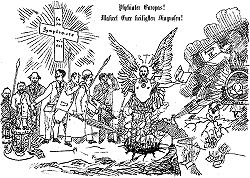Anti-psychiatry
There are a number of social and political movements that question certain practices of psychiatry, which became known as anti-psychiatry. One movement originated during the French Revolution of 1789 and was influenced by romantic ideals. Another movement started in Germany around 1900. The third big movement was stated in the United States and Europe in the 1960s. This movement questioned the classification of Schizophrenia as a mental illness, to be treated by psychiatry and also wanted to highlight certain problems of psychiatric wards.
One of the people who influenced the 1960s movement a great deal was Michel Foucault. His book Madness and Insanity: History of Madness in the Classical Age is about the question at what point madness starts.
South African psychiatrist David Cooper was the first to use the word “anti-psychiatry”. He first used it in 1967.[1]
Anti-psychiatry Media
Vienna's Narrenturm—German for "fools' tower"—was one of the earliest buildings specifically designed as a "madhouse". It was built in 1784.
Internee in a restraint chair at the West Riding Pauper Lunatic Asylum, 1869
Graveyard attached to the Church of St. Thomas in West Yorkshire, England, where thousands of internees from Storthes Hall Hospital are buried in unmarked graves
The Royal Earlswood Asylum for Idiots was the first hospital for people with learning disabilities, led by Lord Palmerston, Baron Rothschild and Lord Ashley in the 1850s
Scientologists on an anti-psychiatry demonstration
"Psychiater Europas! Wahret Eure heiligsten Diagnosen!" ("Psychiatrists of Europe! Protect your sanctified diagnoses!"), says the inscription on the cartoon by Emil Kraepelin, who introduced the schizophrenia concept, "Bierzeitung", Heidelberg, 1896
Notes
- ↑ David Cooper, Psychiatry and Anti-Psychiatry, Paladin, London, 1967.








